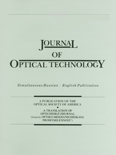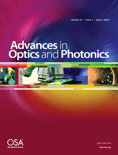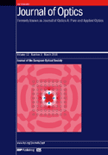
Journal of the European Optical Society-Rapid Publications
Scope & Guideline
Illuminating the Path to Optical Advancements
Introduction
Aims and Scopes
- Optical Measurement and Instrumentation:
The journal publishes research on novel optical measurement techniques and instruments, emphasizing advancements in precision and application across various fields such as agriculture, medicine, and materials science. - Nanophotonics and Metamaterials:
Research on nanophotonic devices and metamaterials is a core focus, with contributions exploring their unique optical properties and applications in sensing, imaging, and communication. - Laser Technology and Applications:
The journal features studies on laser development, including novel laser sources, their applications in spectroscopy, imaging, and material processing, highlighting innovations that enhance performance or introduce new functionalities. - Computational and Theoretical Optics:
A significant portion of the published works involves computational techniques in optics, including modeling, simulations, and algorithm development, aimed at solving complex optical phenomena and optimizing systems. - Biophotonics and Medical Applications:
Research addressing the application of optical technologies in biomedical contexts is prevalent, including diagnostics, imaging, and therapeutic techniques, which leverage the unique interactions of light with biological tissues. - Advanced Imaging Techniques:
The journal explores cutting-edge imaging methodologies such as holography, microscopy, and spectroscopy, focusing on their advancements and practical implementations in various scientific and industrial applications.
Trending and Emerging
- Machine Learning and AI in Optics:
There is a significant increase in the application of machine learning and artificial intelligence techniques in optical research, particularly in imaging and data analysis, indicating a trend towards integrating computational intelligence with traditional optical methods. - Sustainable and Green Photonics:
Emerging studies focus on sustainable photonic technologies, including energy-efficient devices and environmentally friendly materials, reflecting a growing awareness of the ecological impacts of optical technologies. - Quantum Technologies:
Research related to quantum optics, including quantum communication and quantum sensing, is rapidly gaining traction, showcasing the potential of quantum phenomena in revolutionizing optical technologies. - Terahertz and Ultrafast Optics:
The exploration of terahertz technologies and ultrafast optical phenomena is on the rise, with applications ranging from spectroscopy to material characterization being increasingly emphasized. - Wearable and Portable Optical Devices:
Innovations in wearable and portable optical sensing devices are trending, particularly in health monitoring and environmental sensing, showcasing the practical applications of optics in everyday technology.
Declining or Waning
- Conventional Optical Devices:
There is a noticeable reduction in research focused on traditional optical devices, such as standard lenses and mirrors, as the field increasingly shifts towards integrating advanced materials and technologies. - Basic Optical Physics:
Papers emphasizing fundamental optical physics principles, such as simple interference or diffraction phenomena, are becoming less common, as researchers tend to pursue more applied and innovative approaches in optics. - Static Optical Measurements:
Research involving static or non-dynamic measurement techniques is declining, with a growing preference for dynamic, real-time, and adaptive measurement systems that can provide more insightful data.
Similar Journals

Optica Pura y Aplicada
Exploring the Depths of Atomic and Molecular PhysicsOptica Pura y Aplicada, published by the SOC ESPANOLA OPTICA, stands as a vital platform for the dissemination of cutting-edge research in the fields of Atomic and Molecular Physics, Optics, and related engineering disciplines. Established in Spain, this journal aims to foster the advancement of knowledge in optical science and technology by providing a rigorous peer-reviewed publication outlet for scholars, researchers, and practitioners. Despite being categorized in the Q4 quartile across multiple domains, including Engineering and Materials Science, the journal remains committed to contributing meaningful insights and advancements within its scope. With an ISSN of 0030-3917 and an E-ISSN of 2171-8814, the journal effectively reaches a global audience eager to explore innovative applications and theoretical developments in optics and materials science. Researchers and professionals alike will find in Optica Pura y Aplicada a valuable resource for enriching their understanding and practices in an ever-evolving field, fostering collaborations and promoting research growth until its converged conclusion in 2024.

OPTICAL REVIEW
Illuminating the Future of Optical ScienceOPTICAL REVIEW is a distinguished journal published by the Optical Society of Japan that serves as a critical platform for researchers, professionals, and students within the diverse fields of atomic and molecular physics and optics. With its ISSN 1340-6000 and E-ISSN 1349-9432, the journal has had a significant impact on the dissemination of knowledge since its inception in 1994, with a planned coverage until 2024. Although it currently holds a Q4 ranking in the 2023 category quartiles and is positioned at rank #152 out of 224 in the Scopus database, its contributions are vital for advancing optical science. This journal provides a venue for innovative research, review articles, and significant developments that drive the optical sciences forward. Although not categorized as Open Access, it remains an important resource for those seeking to deepen their knowledge and engage with leading-edge research in optics. With its base located at the Kudan-Kita Building in the heart of Tokyo, Germany, OPTICAL REVIEW is poised to continue fostering scholarly communication and collaboration on a global scale.

Current Optics and Photonics
Driving Discovery in the Dynamic Field of LightCurrent Optics and Photonics is a premier journal published by the Optical Society Korea, focusing on the dynamic and evolving fields of optics and photonics. With an ISSN of 2508-7266 and E-ISSN 2508-7274, it provides a comprehensive platform for scholarly communication, emphasizing innovations, advances in technology, and theoretical developments in atomic and molecular physics and optics. Situated in South Korea's vibrant academic landscape, this open access journal aims to bridge the gap between theoretical research and practical applications, fostering collaboration and knowledge sharing among researchers, professionals, and students alike. Although currently ranked in the Q3 category for both Atomic and Molecular Physics and Optics, with a Scopus rank of #183/224, it showcases significant contributions that enhance understanding in these critical areas. The journal encourages submission of original research articles, reviews, and technical notes, with the objective of driving forward the conversation in optics and photonics throughout its converged years from 2017 to 2024. Embrace the opportunity to contribute to this expanding field and become part of a community that is at the forefront of scientific discovery.

Photonics
Exploring the Frontiers of Light and TechnologyPhotonics, an esteemed journal published by MDPI, is a leading platform for researchers in the fields of atomic and molecular physics, optics, and instrumentation. Since its inception in 2014, the journal has fostered open access to cutting-edge research, facilitating knowledge dissemination in these dynamic disciplines. With its Q2 ranking in the 2023 Scopus metrics for various categories, including radiology, nuclear medicine, and imaging, Photonics represents a crucial academic resource for professionals and students seeking to advance their understanding and expertise. Located in Basel, Switzerland, the journal plays a pivotal role in bridging theoretical and practical approaches to photonic technologies. Researchers are encouraged to contribute their findings, thereby enriching the journal’s impact and relevance in the global scientific community through collaboration and innovation.

JOURNAL OF OPTICAL TECHNOLOGY
Unveiling Breakthroughs in Light TechnologyJOURNAL OF OPTICAL TECHNOLOGY, published by the Optica Publishing Group, serves as a vital resource for researchers and professionals in the fields of optical technology and related disciplines. Established with a commitment to advancing knowledge, this journal spans a broad spectrum of topics, including applied mathematics, atomic and molecular physics, and various engineering disciplines, with a converged publication period from 1995 to 2024. Although it currently holds a Q4 ranking across multiple categories in 2023, it is an important platform for innovative research ideas in a rapidly evolving field. The absence of Open Access may guide readers to explore alternative access options through institutional subscriptions. The journal’s ISSN is 1070-9762 and its E-ISSN is 1091-0786, ensuring accessibility for a global audience. As a publication aimed at fostering scholarly communication, it invites contributions that highlight emerging trends and novel developments in optical technology, catering to a multifaceted audience of researchers, professionals, and students.

Optics is a pioneering open access journal published by MDPI, dedicated to advancing the field of optics and photonics. Since its inception in 2020, the journal has fostered the dissemination of high-quality research and innovative developments in optical sciences, contributing significantly to its community of researchers, professionals, and students in Switzerland and beyond. With an impact factor reflective of its growing prominence, Optics strives to address a diverse scope, encompassing atomic and molecular physics, electronic materials, and broader topics in physics and astronomy. The journal's commitment to open access ensures that cutting-edge research is freely available, promoting collaboration and knowledge-sharing across disciplines. As of 2023, it holds a Q4 ranking in several categories, including Atomic and Molecular Physics, and Optics, which illustrates its evolving role in the academic landscape, positioning it as a valuable resource for those seeking to explore the frontiers of optical technology and its applications.

Journal of Optics-India
Exploring the Depths of Optical KnowledgeThe Journal of Optics-India, published by SPRINGER INDIA, serves as a vital platform dedicated to advancing research in the field of optics, focusing on topics in both atomic and molecular physics. With an ISSN of 0972-8821 and an E-ISSN of 0974-6900, the journal has been a consistent contributor to the field since its inception in 1996 and continues to thrive with its anticipated convergence through 2024. Although currently classified in Q3 of the 2023 category quartiles, the journal actively seeks to elevate its standing within Scopus rankings in physics and astronomy, where it holds a rank of 143/224, indicating significant opportunities for growth and research impact. The Journal of Optics-India is committed to fostering innovative research and providing scholars and practitioners with access to cutting-edge findings, thereby enhancing global conversations around optics and its vast applications. As a reliable source for researchers, professionals, and students alike, the journal emphasizes quality contributions that shape the future of optical science.

Advances in Optics and Photonics
Leading the Charge in Photonic Research ExcellenceAdvances in Optics and Photonics, published by the Optica Publishing Group, stands at the forefront of research dissemination in the fields of Atomic and Molecular Physics and Optics, alongside its prominence in Water Science and Technology. With an impressive Q1 ranking in both categories and a Scopus rank of #2/224, this journal boasts a 99th percentile status, underscoring its significance in the academic community. As a beacon of knowledge since its inception in 2009, the journal is dedicated to featuring cutting-edge research, innovative methodologies, and transformative applications in optics and photonics that can drive advancements across diverse scientific domains. While not an open-access journal, it provides vital insights for researchers, professionals, and students eager to stay updated on emerging trends and breakthroughs. With a convergence period extending to 2024, Advances in Optics and Photonics is positioned as an essential resource for anyone looking to explore the evolving landscape of light-based technologies.

Journal of Optics
Empowering Discoveries in the World of LightThe Journal of Optics, published by IOP Publishing Ltd, stands as a pivotal platform for disseminating cutting-edge research in the fields of atomic, molecular physics, and optics as well as electronic, optical, and magnetic materials. With an impact factor reflective of its esteemed position—ranking in the 60th percentile in both relevant Scopus categories—this journal, boasting an ISSN of 2040-8978 and an E-ISSN of 2040-8986, is uniquely positioned to foster innovation and collaboration among researchers, professionals, and students worldwide. Located in the United Kingdom and operational since 2010, the journal embraces an open access model, promoting maximal reach and engagement with the latest discoveries that shape the future of optics. As it continues to evolve through its converged years up to 2024, the Journal of Optics remains a critical resource for those seeking to advance their knowledge and influence in this dynamic field.

JOURNAL OF RUSSIAN LASER RESEARCH
Pioneering Research in Optics and EngineeringThe Journal of Russian Laser Research, published by Springer, stands as a vital resource for researchers and professionals in the fields of atomic and molecular physics, as well as optics and engineering. With its ISSN 1071-2836 and E-ISSN 1573-8760, this journal has been disseminating groundbreaking research since its inception in 1994, with a dedicated focus on the advancement of laser technologies and their applications. While it currently holds a Q4 classification in both Atomic and Molecular Physics and Engineering categories, its commitment to fostering novel insights and innovative methodologies positions it as a promising platform for emerging studies within these disciplines. Although the journal does not offer open access options, it continues to draw attention with a growing citation index. By publishing diverse research articles, reviews, and critical discussions, the Journal of Russian Laser Research not only enriches academic literature but also serves as a stepping stone for students and professionals seeking to deepen their understanding of laser science and its myriad applications.